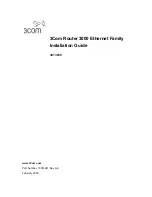
Responder time responder
U
SER
G
UIDE
352
R
ESPONDER TIME RESPONDER
C
ONFIGURATION
The RTR (Responder Time Reporter) service gives the possibility to execute commands according to
a specific RTR watcher configured. More precisely, RTR functionality allows the configuration of
probes to be sent to a pre-configured address in order to measure performance and network
latency times.
With the commands:
set rtr frequency <seconds>
set rtr timeout <millisec>
set rtr lifetime <seconds>
set rtr pkt-size <bytes>
set rtr tos <value>
it is possible to configure the frequency (in seconds) to send probes, the latency (in milliseconds)
for the reply to the probe, the duration of the probe (
0
corresponds to an infinite duration), the size
of the probe packet (in bytes), the Type of Service value (from
2
to
254
).
It is also possible to choose that the probe is created from an i
icmp echo request
, operation,
from the transmission of a UDP packet or from a request of connection to a given service, towards a
given destination address. The commands are:
set rtr type ipIcmpEcho dst-addr <value> [src-addr <value>]
it defines that the probe is created from an ICMP echo request packet towards the address
dst-
addr
(and optionally with source address
src-addr
).
set rtr type udpEcho dst-addr <value> <dst-port> <value> [src-addr <value> [src-addr <value>]]
It defines that the probe is created from a UDP packet towards the address
dst-host
and port
dst-
port
.
It is possible to specify the
src-addr
source address also, with which the packet must be
sent. In this case it is possible to specify the
src-port
source port also. Like:
set rtr type udpEcho dst-addr 192.168.206.1 dst-port 1234 src-addr 192.168.206.38 src-port 11000
set rtr type tcpConnect dst-addr <value> <dst-port> <value> [ src-addr <value> [src-addr <value>]]
tells that the probe is made by a connection request to the
dst-port
service towards
dst-host
address
.
set rtr type udpJitter dst-addr <value> <dst-port> <value> [src-addr <value> [src-addr <value>]]
defines an operation according to the protocol Cisco IP SLA UDP-Jitter, to the
dst-host
address and
dst-port
port. You can also specify the
src-addr
source address and
src-port
source port, to
which the packet has to be send.
With the command:
set rtr threshold N
A threshold value is established. When this value is exceeded, all the actions configured with the
command
set rtr reaction-event
are executed (the command is described later).
set rtr reaction-event ifFailure <command>
















































